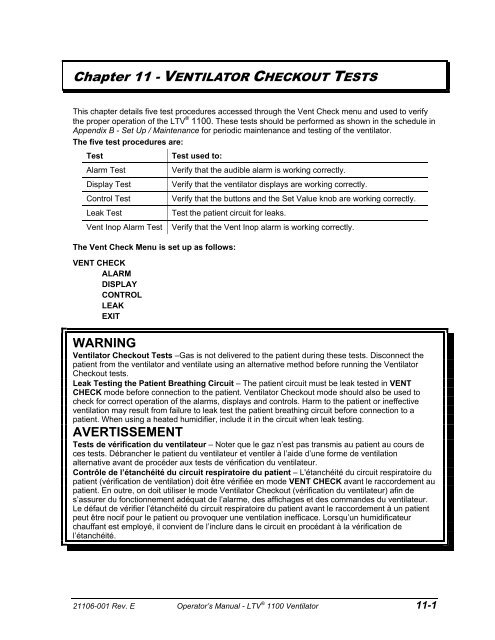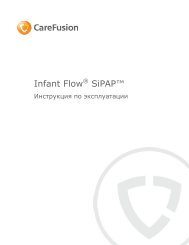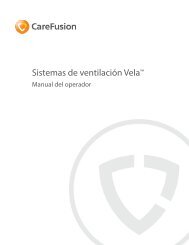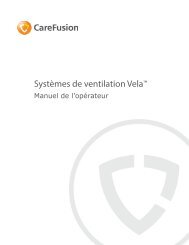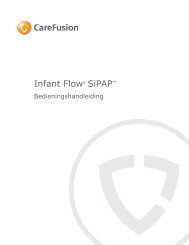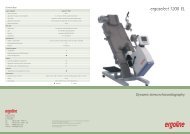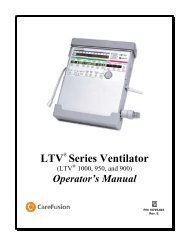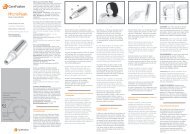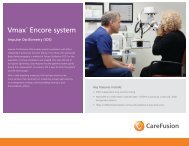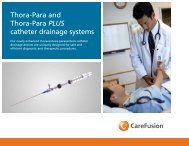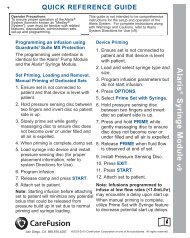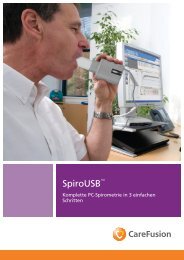LTV 1100 Operator Manual - CareFusion
LTV 1100 Operator Manual - CareFusion
LTV 1100 Operator Manual - CareFusion
You also want an ePaper? Increase the reach of your titles
YUMPU automatically turns print PDFs into web optimized ePapers that Google loves.
Chapter 11 - VENTILATOR CHECKOUT TESTS<br />
This chapter details five test procedures accessed through the Vent Check menu and used to verify<br />
the proper operation of the <strong>LTV</strong> ® <strong>1100</strong>. These tests should be performed as shown in the schedule in<br />
Appendix B - Set Up / Maintenance for periodic maintenance and testing of the ventilator.<br />
The five test procedures are:<br />
Test<br />
Test used to:<br />
Alarm Test<br />
Verify that the audible alarm is working correctly.<br />
Display Test<br />
Verify that the ventilator displays are working correctly.<br />
Control Test<br />
Verify that the buttons and the Set Value knob are working correctly.<br />
Leak Test<br />
Vent Inop Alarm Test<br />
Test the patient circuit for leaks.<br />
The Vent Check Menu is set up as follows:<br />
VENT CHECK<br />
ALARM<br />
DISPLAY<br />
CONTROL<br />
LEAK<br />
EXIT<br />
Verify that the Vent Inop alarm is working correctly.<br />
WARNING<br />
Ventilator Checkout Tests –Gas is not delivered to the patient during these tests. Disconnect the<br />
patient from the ventilator and ventilate using an alternative method before running the Ventilator<br />
Checkout tests.<br />
Leak Testing the Patient Breathing Circuit – The patient circuit must be leak tested in VENT<br />
CHECK mode before connection to the patient. Ventilator Checkout mode should also be used to<br />
check for correct operation of the alarms, displays and controls. Harm to the patient or ineffective<br />
ventilation may result from failure to leak test the patient breathing circuit before connection to a<br />
patient. When using a heated humidifier, include it in the circuit when leak testing.<br />
AVERTISSEMENT<br />
Tests de vérification du ventilateur – Noter que le gaz n’est pas transmis au patient au cours de<br />
ces tests. Débrancher le patient du ventilateur et ventiler à l’aide d’une forme de ventilation<br />
alternative avant de procéder aux tests de vérification du ventilateur.<br />
Contrôle de l’étanchéité du circuit respiratoire du patient – L'étanchéité du circuit respiratoire du<br />
patient (vérification de ventilation) doit être vérifiée en mode VENT CHECK avant le raccordement au<br />
patient. En outre, on doit utiliser le mode Ventilator Checkout (vérification du ventilateur) afin de<br />
s’assurer du fonctionnement adéquat de l’alarme, des affichages et des commandes du ventilateur.<br />
Le défaut de vérifier l’étanchéité du circuit respiratoire du patient avant le raccordement à un patient<br />
peut être nocif pour le patient ou provoquer une ventilation inefficace. Lorsqu’un humidificateur<br />
chauffant est employé, il convient de l’inclure dans le circuit en procédant à la vérification de<br />
l’étanchéité.<br />
21106-001 Rev. E <strong>Operator</strong>’s <strong>Manual</strong> - <strong>LTV</strong> ® <strong>1100</strong> Ventilator 11-1


